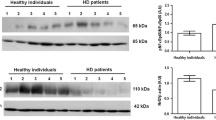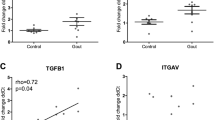Abstract
There is evidence regarding the association of hyperuricemia with inflammatory disorders. Hence, it has been of particular interest to dissect the exact role of alteration in uric acid (UA) levels in the context of inflammation. Recently, the endoplasmic reticulum (ER) stress pathway has come into the forefront as a possible mechanism linking hyperuricemia to inflammation. Here, we intended to examine the role of UA in the presence or absence of a second stimulus, LPS, in human peripheral blood mononuclear cells (PBMCs), and analyzed ROS production as well as expression of ER stress markers: GRP78 and CHOP, and inflammatory cytokines.
PBMCs were isolated using Ficoll gradient centrifugation from healthy volunteers. Cell viability was measured by MTT assay. PBMCs were treated with an increasing concentration of soluble UA (0, 5, 12, and 20 mg/dl) for 20 h, followed by the addition of 100 ng/mL of LPS or vehicle for another 4 h. Real time-PCR was performed to investigate the mRNA expression of GRP78, CHOP, TNF-α, IL-1β, and IL-6, and western blot was used to investigate the protein levels of GRP78 and CHOP. Moreover, ELISA was used to evaluate the protein levels of TNF-α, IL-1β, and IL-6. Finally, intracellular ROS production was determined using fluorescent probes (DCFH-DA).
High concentrations of UA either alone or combined with LPS increased the protein levels of GRP78 and CHOP. On the other hand, LPS alone increased the protein levels of GRP78 and CHOP. However, there was no significant difference between the mRNA expression of GRP78, CHOP, TNF-α, IL-1β, and IL-6 when PBMCs were treated with UA. High concentrations of UA augmented LPS-stimulated IL-1β transcript and protein levels as well as TNF-α protein levels in PBMC culture. Moreover, high concentrations of UA along with LPS significantly increased intracellular ROS production.
It seems that a high concentration of UA not only induces the protein levels of ER stress markers in PBMCs but also augments the impact of LPS on the levels of pro-inflammatory markers and ROS production.






Similar content being viewed by others
Data availability
The data that support the findings of this study are available from the corresponding author under request.
References
Akahoshi T, Namai R, Murakami Y, Watanabe M, Matsui T, Nishimura A et al (2003) Rapid induction of peroxisome proliferator–activated receptor γ expression in human monocytes by monosodium urate monohydrate crystals. Arthritis Rheum 48(1):231–239
Albertoni G, Maquigussa E, Pessoa E, Barreto JA, Borges F, Schor N (2010) Soluble uric acid increases intracellular calcium through an angiotensin II-dependent mechanism in immortalized human mesangial cells. Exp Biol Med (Maywood) 235(7):825–832
Arai Y, Nishinaka Y, Arai T, Morita M, Mizugishi K, Adachi S et al (2014) Uric acid induces NADPH oxidase-independent neutrophil extracellular trap formation. Biochem Biophys Res Commun 443(2):556–561
Baldwin W, McRae S, Marek G, Wymer D, Pannu V, Baylis C et al (2011) Hyperuricemia as a mediator of the proinflammatory endocrine imbalance in the adipose tissue in a murine model of the metabolic syndrome. Diabetes 60(4):1258–1269
Braga TT, Forni MF, Correa-Costa M, Ramos RN, Barbuto JA, Branco P et al (2017) Soluble uric acid activates the NLRP3 inflammasome. Sci Rep 7:39884
Burgos-Morón E, Abad-Jiménez Z, Marañón AM, Iannantuoni F, Escribano-López I, López-Domènech S, et al. Relationship between oxidative stress, ER stress, and inflammation in type 2 diabetes: the battle continues. J Clin Med. 2019;8(9)
Cao SS, Kaufman RJ (2014) Endoplasmic reticulum stress and oxidative stress in cell fate decision and human disease. Antioxid Redox Signal 21(3):396–413
Choi YJ, Shin HS, Choi HS, Park JW, Jo I, Oh ES et al (2014) Uric acid induces fat accumulation via generation of endoplasmic reticulum stress and SREBP-1c activation in hepatocytes. Laboratory investigation a Journal of technical methods and pathology. 94(10):1114–25
Convento M, Pessoa E, Dalboni MA, Borges F, Schor N (2011) Pro-inflammatory and oxidative effects of noncrystalline uric acid in human mesangial cells: contribution to hyperuricemic glomerular damage. Urol Res 39(1):21–27
Crisan TO, Cleophas MC, Oosting M, Lemmers H, Toenhake-Dijkstra H, Netea MG et al (2016) Soluble uric acid primes TLR-induced proinflammatory cytokine production by human primary cells via inhibition of IL-1Ra. Ann Rheum Dis 75(4):755–762
Crişan TO, Cleophas MCP, Novakovic B, Erler K, van de Veerdonk FL, Stunnenberg HG et al (2017) Uric acid priming in human monocytes is driven by the AKT–PRAS40 autophagy pathway. Proc Natl Acad Sci 114(21):5485–5490
Giamarellos-Bourboulis EJ, Mouktaroudi M, Bodar E, van der Ven J, Kullberg BJ, Netea MG et al (2009) Crystals of monosodium urate monohydrate enhance lipopolysaccharide-induced release of interleukin 1 beta by mononuclear cells through a caspase 1-mediated process. Ann Rheum Dis 68(2):273–278
Gong M, Wen S, Nguyen T, Wang C, Jin J, Zhou L (2020) Converging relationships of obesity and hyperuricemia with special reference to metabolic disorders and plausible therapeutic implications. Diabetes Metab Syndr Obes 13:943–962
Hamada J, Onuma H, Ochi F, Hirai H, Takemoto K, Miyoshi A et al (2016) Endoplasmic reticulum stress induced by tunicamycin increases resistin messenger ribonucleic acid through the pancreatic endoplasmic reticulum eukaryotic initiation factor 2α kinase–activating transcription factor 4–CAAT/enhancer binding protein-α homologous protein pathway in THP-1 human monocytes. Journal of diabetes investigation 7(3):312–323
Hâncu N, Netea MG, Baciu I (1998) High glucose concentrations increase the tumor necrosis factor-alpha production capacity by human peripheral blood mononuclear cells. Rom J Physiol 35(3–4):325–330
Hwang HS, Yang CM, Park SJ, Kim HA (2015) Monosodium urate crystal-induced chondrocyte death via autophagic process. Int J Mol Sci 16(12):29265–29277
Jin M, Yang F, Yang I, Yin Y, Luo JJ, Wang H et al (2012) Uric acid, hyperuricemia and vascular diseases. Frontiers in bioscience (Landmark edition) 17:656–669
Kanbay M, Jensen T, Solak Y, Le M, Roncal-Jimenez C, Rivard C et al (2016) Uric acid in metabolic syndrome: from an innocent bystander to a central player. Eur J Intern Med 29:3–8
Kanellis J, Watanabe S, Li JH, Kang DH, Li P, Nakagawa T et al (2003) Uric acid stimulates monocyte chemoattractant protein-1 production in vascular smooth muscle cells via mitogen-activated protein kinase and cyclooxygenase-2. Hypertension (Dallas, Tex : 1979) 41(6):1287–93
Khodabandehloo H, Seyyedebrahimi S, Esfahani EN, Razi F, Meshkani R (2018) Resveratrol supplementation decreases blood glucose without changing the circulating CD14(+)CD16(+) monocytes and inflammatory cytokines in patients with type 2 diabetes: a randomized, double-blind, placebo-controlled study. Nutr Res 54:40–51
Kim SK, Choe JY, Park KY (2019) Anti-inflammatory effect of artemisinin on uric acid-induced NLRP3 inflammasome activation through blocking interaction between NLRP3 and NEK7. Biochem Biophys Res Commun 517(2):338–345
Li S, Zhao F, Cheng S, Wang X, Hao Y (2013) Uric acid-induced endoplasmic reticulum stress triggers phenotypic change in rat glomerular mesangial cells. Nephrology (Carlton) 18(10):682–689
Liu-Bryan R, Scott P, Sydlaske A, Rose DM, Terkeltaub R (2005) Innate immunity conferred by Toll-like receptors 2 and 4 and myeloid differentiation factor 88 expression is pivotal to monosodium urate monohydrate crystal–induced inflammation. Arthritis Rheum 52(9):2936–2946
Lonardo A, Nascimbeni F, Maurantonio M, Marrazzo A, Rinaldi L, Adinolfi LE (2017) Nonalcoholic fatty liver disease: evolving paradigms. World J Gastroenterol 23(36):6571–6592
Mazloom H, Alizadeh S, Pasalar P, Esfahani EN, Meshkani R (2015) Downregulated microRNA-155 expression in peripheral blood mononuclear cells of type 2 diabetic patients is not correlated with increased inflammatory cytokine production. Cytokine 76(2):403–408
Mylona EE, Mouktaroudi M, Crisan TO, Makri S, Pistiki A, Georgitsi M et al (2012) Enhanced interleukin-1β production of PBMCs from patients with gout after stimulation with Toll-like receptor-2 ligands and urate crystals. Arthritis Res Ther 14(4):R158
Oguz N, Kirca M, Cetin A, Yesilkaya A (2017) Effect of uric acid on inflammatory COX-2 and ROS pathways in vascular smooth muscle cells. J Recept Signal Transduct Res 37(5):500–505
Ok EJ, Kim K, Park SB (2018) Association between serum uric acid and oxidative stress in Korean adults. Korean journal of family medicine 39(5):295–299
Richette P, Doherty M, Pascual E, Barskova V, Becce F, Castañeda-Sanabria J et al (2017) 2016 updated EULAR evidence-based recommendations for the management of gout. Ann Rheum Dis 76(1):29–42
Sautin YY, Nakagawa T, Zharikov S, Johnson RJ (2007) Adverse effects of the classic antioxidant uric acid in adipocytes: NADPH oxidase-mediated oxidative/nitrosative stress. Am J Physiol Cell Physiol 293(2):C584–C596
Scott P, Ma H, Viriyakosol S, Terkeltaub R, Liu-Bryan R (2006) Engagement of CD14 mediates the inflammatory potential of monosodium urate crystals. J Immunol 177(9):6370–6378
Toyama BH, Hetzer MW (2013) Protein homeostasis: live long, won’t prosper. Nat Rev Mol Cell Biol 14(1):55–61
Xu C, Bailly-Maitre B, Reed JC (2005) Endoplasmic reticulum stress: cell life and death decisions. J Clin Investig 115(10):2656–2664
Yan M, Chen K, He L, Li S, Huang D, Li J (2018) Uric acid induces cardiomyocyte apoptosis via activation of calpain-1 and endoplasmic reticulum stress. Cell Physiol Biochem 45(5):2122–2135
Yu MA, Sánchez-Lozada LG, Johnson RJ, Kang DH (2010) Oxidative stress with an activation of the renin-angiotensin system in human vascular endothelial cells as a novel mechanism of uric acid-induced endothelial dysfunction. J Hypertens 28(6):1234–1242
Zhang K, Kaufman RJ (2008) From endoplasmic-reticulum stress to the inflammatory response. Nature 454(7203):455–462
Zhang Y, Hong Q, Huang Z, Xue P, Lv Y, Fu B et al (2014) ALDR enhanced endothelial injury in hyperuricemia screened using SILAC. Cell Physiol Biochem 33(2):479–490
Zhang Y, Yamamoto T, Hisatome I, Li Y, Cheng W, Sun N et al (2013) Uric acid induces oxidative stress and growth inhibition by activating adenosine monophosphate-activated protein kinase and extracellular signal-regulated kinase signal pathways in pancreatic β cells. Mol Cell Endocrinol 375(1–2):89–96
Zughaier SM, Stauffer BB, McCarty NA (2014) Inflammation and ER stress downregulate BDH2 expression and dysregulate intracellular iron in macrophages. J Immunol Res 2014
Acknowledgements
The present manuscript has been derived from an M.Sc. thesis (number: 9511180001).
Funding
This research was supported by the Tehran University of Medical Sciences (Grant No: 960430–36630).
Author information
Authors and Affiliations
Contributions
Reyhane Ebrahimi: methodology and writing—original draft.
Parvin Pasalar: data curation
Hajar Shokri: methodology
Maryam Shabani: methodology
Solaleh Emamgholipour: conceptualization, supervision, validation, project administration, funding acquisition, and writing—review and editing
The authors declare that all data were generated in-house and that no paper mill was used.
Corresponding author
Ethics declarations
Ethics approval
The study protocol was approved by the Ethics Committee of Tehran University of Medical Sciences (Code of IR.TUMS.MEDICINE.REC.1396.4266).
Consent to participate
All participants signed the informed consent before participation.
Conflict of interest
The authors declare no competing interests.
Additional information
Publisher's note
Springer Nature remains neutral with regard to jurisdictional claims in published maps and institutional affiliations.
Key points
• Hyperuricemia has been considered as a potential biomarker pertinent to several modern-society diseases.
• The addition of a high concentration of uric acid to PBMCs increases the protein levels of ER stress markers: GRP78 and CHOP either alone or combined with LPS.
• A high concentration of uric acid along with LPS elicits the levels of IL-1β, TNF-α, and intracellular ROS production in PBMCs.
• It seems that ER stress can be considered as a possible mechanism linking hyperuricemia to regulating inflammatory pathways and ROS production
Supplementary Information
Below is the link to the electronic supplementary material.
Rights and permissions
About this article
Cite this article
Ebrahimi, R., Pasalar, P., Shokri, H. et al. Evidence for the effect of soluble uric acid in augmenting endoplasmic reticulum stress markers in human peripheral blood mononuclear cells. J Physiol Biochem 78, 343–353 (2022). https://doi.org/10.1007/s13105-021-00869-y
Received:
Accepted:
Published:
Issue Date:
DOI: https://doi.org/10.1007/s13105-021-00869-y




